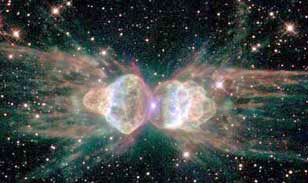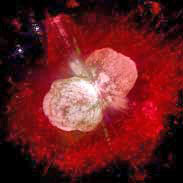|
CHAPTER 2
MYSTERIES OF THE COSMIC
THUNDERBOLT
|
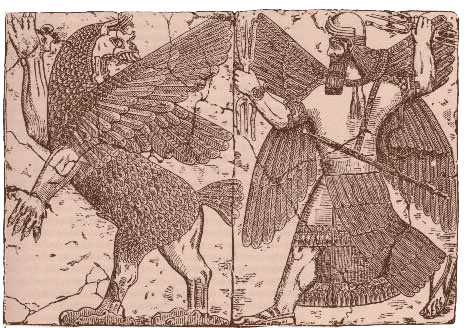
“On the mountainside
Anzu and Ninurta met … Clouds of death rained down, an
arrow flashed lightning. Whizzed the battle force roared between
them.“
Anzu Epic, tablet
2,
in S. Dalley,
Myths from Mesopotamia
(Oxford - New York,
1989), p. 21. |
If Anthony Peratt’s conclusions are correct, then only a few
thousand years ago the terrestrial sky was ablaze with electrical
activity.
The ramifications of
this possibility will directly affect our understanding of cultural
roots. What was the impact of the recorded events on the first
civilizations? What was the relationship to the origins of world
mythology, to the birth of the early religions, or to monumental
construction in ancient times?
|
The relatively sudden
appearance of the rock art themes discussed in the previous chapter
interrupted a well-documented earlier phase in the evolution of
artistic expression. In the remote Paleolithic epoch, we see
remarkable human skill in representing the natural world.
Many
observers have marveled at the realism of primitive depictions on
the walls of caves in Europe and elsewhere, showing antelope and
bison and other animal and plant forms, with great attention to
natural detail. Many of the most impressive examples are
conventionally dated around twenty to thirty thousand years ago.
Later, however, in close connection to the beginnings of
civilization, we observe an explosion of human energy devoted to the
utterly fantastic: cosmic serpents and dragons, winged bulls in the
sky, mountains, towers, and stairways reaching to the center of
heaven, “sun” disks with heaven-spanning wings, cosmic “ships”
sailing about the sky.
In fact, most researchers have grown so used
to these preposterous images that only rarely do they pause to
notice the enigma. How did it happen that human consciousness
shifted from artistic accuracy and natural representation in the
more “primitive” (Paleolithic) stage, to such bold “defiance of
nature” in a later (Neolithic) stage? From any conventional vantage
point, a collapse of artistic “skill” also occurred.
But now, there is reason to believe that rock art can illuminate a
critical turn in human history. Before the work of Peratt,
the petroglyphs appeared to be little more than “stick figures” with
preposterous attributes, all easily dismissed as random
“hallucination” or “doodling.”
Peratt’s work assures us that
the basic forms have a direct explanation in plasma science.
|
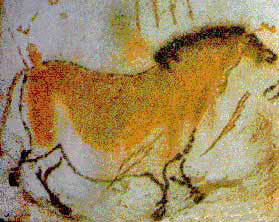 |
|
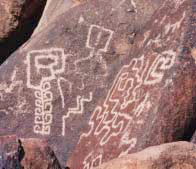
UPPER:
Paleolithic cave painting of a horse, France. LOWER:
Images such as these carved on stone in the southwestern
U.S., accent the enigma: the task of chiseling such images
required an immense investment of human time and energy, yet
the forms appear to be little more than doodling. Plasma
physics will tell us otherwise, however. |
There is also a provable
connection to the evolution of mythical archetypes. Archaic rock art
depictions came first, but were followed by an outpouring of
conceptual elaborations, as ancient artists gave imaginative
expression to the celestial forms and events that inspired the
myth-making epoch. Both the rock artists and the myth-makers had
true perils on their minds. The rock artists recorded and the
myth-makers interpreted electrical events in the sky, as plasma
discharge sequences moved through discrete phases, some of celestial
beauty, others intensely violent and terrifying.
Our world was once a vastly different place—that is the message
written on stone and concealed within the archetypes of world
mythology. As for the myths, it is only necessary that we see past
the imaginative expressions to the events behind them. What were the
events that provoked an explosion of human imagination prior to the
rise of civilization? All of the archetypes are, in fact,
extraordinary.
Not one answers to familiar events in our sky today.
The Dragon, the Hero, and the Thunderbolt
|
As if speaking with a
single voice, ancient cultures declare that fantastic beasts once
roamed the heavens and the gods went to war. In the story’s most
common form, the upheaval began when a great serpent or dragon
attacked the world, bringing darkness and universal devastation. A
legendary warrior then set out to engage the monster in direct
combat. The battle raged amid earthquake, fire, wind, and falling
stone, and it appeared that all would be lost. Then the hero’s
magical weapon, fashioned by gods or divine assistants, flew between
the combatants, turning the tide of battle and vanquishing the
monster.
From this encounter, the ancestral warrior earned his title as
"hero." He defeated chaos and saved the world from catastrophe. But
how did the divine weapon accomplish this feat? The storytellers’
own words and symbols, when traced to root meanings, make clear that
the hero’s weapon was no ordinary sword, arrow, or club. It was a
thunderbolt—and not the familiar lightning of a regional storm, but
a bolt of cosmic dimensions.
Though this original identity may not
be apparent in many of the later versions of the story, it can be
confirmed through cross-cultural comparison, with closest attention
to the memory’s more archaic forms. When the great civilizations of
the ancient world arose, the dragon, the hero, and the cosmic
thunderbolt already dominated human consciousness. |
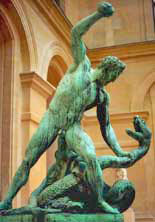
"Hercules
Battling Achelous," the Louvre, Paris, France.
|
The Great Serpent Typhon
Greek poets, historians, and philosophers often spoke of the great
dragon Typhon or Typhoeus whose attack nearly destroyed the world.
|
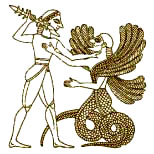
Greek vase
painting depicts Zeus’ conquest of Typhon. |
Our oldest
source for the Typhon story is Hesiod, whose account is
tentatively dated to the eighth century B.C. In his Theogony,
"The Origins of the Gods," Hesiod sets the stage against a
backdrop of cosmic turmoil in the formative phase of earth
history. Typhon was the child of Gaea and
Tartaros,
conceived after Zeus had driven from heaven the former
rulers of the sky, the Titans. At birth, the monster
sprouted a hundred snake heads spitting .re and venom, their
whistles, roars and bellows, and every sort of horrible
sound shaking heaven to its foundations.
Without the
intervention of Zeus, the poet says, the great dragon would
have become the master of gods and of mortals. To meet the
monster, Zeus rose with a clap of thunder. Then "the earth
groaned beneath him, and the heat and blaze from both of
them were on the dark-faced sea, from the thunder and
lightning of Zeus and from the flame of the monster, from
his blazing bolts and from the scorch and breath of his stormwinds." |
The power of Zeus lay in
his lightning-weapons:
…Seizing his
weapons, thunder, lightning, and the glowering thunderbolt,
he made a leap
from Olympos, and struck, setting fire to all
those wonderful heads set about on the dreaded monster.
Then, when
Zeus had put him down with his strokes, Typhon crashed
crippled,
and the gigantic earth groaned beneath him, and the flame
from the
great lord so thunder-smitten ran out… and a great part of
the gigantic
earth burned in
the wonderful wind of his heat… and melted in the
flash of the blazing fire.
Over the centuries
scholars have wondered what natural experience could have provoked
tales of an earth-threatening event in which the agent of
destruction is a serpent or dragon. Was the story a fabulous echo of
ancestral confrontations, when early races struggled to subdue
creatures of the desert or swamp? Or did the story capture, in the
archaic language of myth, a traumatic event—perhaps an eruption
from a nearby volcano, or a hurricane or tornado? Some have
suggested that the Greek memory of Typhon points to a particularly
frightful comet approaching the earth.
The ancient Roman scholar
Pliny mentions the appearance of a "terrible comet" or a "ball of
fire" during the reign of a legendary Egyptian king named
Typhon.
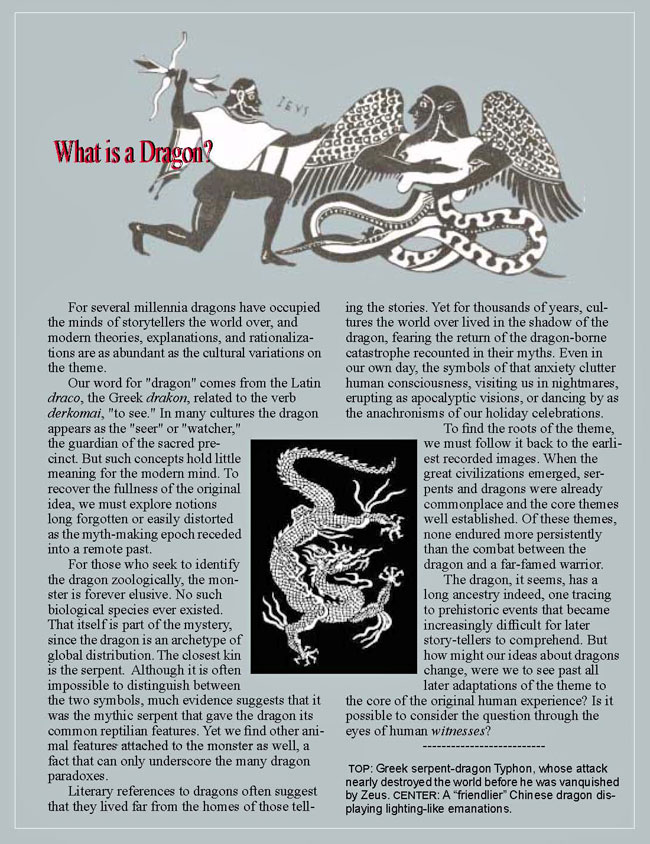
But these naturalistic
speculations take the ancient stories one at a time, in isolation,
and too frequently disregard the parallels within and between
cultures. Hesiod’s version offers many clues that can be followed
backward to the earlier religions of the Mediterranean, the
Near
East, and beyond.
By this line of investigation, we see how the
cosmic serpents and dragons of archetypal mythology were
progressively diminished and localized through regional
storytelling.
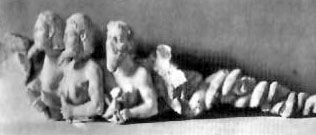
Typhon as
three-headed monster with entwined serpent-tails.
The hero’s combat with
the chaos-serpent or dragon is a global theme of the ancient
cultures, and a failure to recognize this fact will doom any attempt
to comprehend the Typhon story. A ludicrous
monster alien to all natural experience today, but given cosmic
proportions, is indigenous to all cultures’ mythologies.
The
creature is a flaming,
bearded, feathered, or long-haired serpent, often embellished with
multiple heads and mouths, whose writhing form appears in the sky as
chaos and darkness overtake the world. The power and consistency of
the images persist across millennia of human history, and the
collective memory cannot be rationalized away. What was the dragon?
Who was the hero?
And what was the cosmic thunderbolt, the weapon
that left the monster, in the poets’ words, "thunderstruck," or
"lightning-scarred"?
Chaos and the Primeval Rebellion
In ancient Egypt, the serpent Apep was the archenemy of the creator
Ra, and his plotting against Ra produced a tempest in the heavens.
Harking back to these events, numerous Egyptian rites commemorated
the victory of Ra over Apep. At the temple of Ra in Heliopolis the
priests ritually trod underfoot images of Apep to represent his
defeat at the hands of the supreme god. At the temple of Edfu, a
series of reliefs depict the warrior Horus and his followers
vanquishing Apep or his counterpart Set, cutting to pieces the
monster’s companions, the "fiends of darkness."
According to
W. M.
Muller, the spear or harpoon of Horus was a metaphor for the
thunderbolt.
"…Lightning is the spear of
Horus, and thunder the
voice of his wounded antagonist, roaring in his pain."
It is worth
noting as well that the Greeks translated Set as
Typhon.
|

Hindu vajra, the
cosmic thunderbolt. |
In Hindu legends the
great warrior Indra, the most revered god of the Vedas, employed
lightning in his combat with the monstrous Vritra or
Ahi—a giant
serpent who had swallowed both the cosmic "waters" and the sun,
leaving the world in darkness and despair.
-
"Indra,
whose hand wielded thunder, rent piecemeal Ahi who
barred up the waters…"
-
"Loud roared
the mighty hero’s bolt of thunder, when he, the friend
of man, burnt up the monster."
-
"Moreover,
when thou first wast born, o Indra, thou struckest
terror into all the people. Thou, Maghavan, rentest with
thy bolt the dragon who lay against the water floods of
heaven."
|
The Hebrews, too,
preserved an enduring memory of
Yahweh’s battle against a dragon of
the deep, marked by lightning on a cosmic scale.
"The voice of thy
thunder was in the heaven: the lightnings lightened the world: the
earth trembled and shook."
Here the adversary was alternately named
Rahab, Leviathan, Tannin, or
Behemoth—dragon-like forms representing
both the waters of chaos and the rebellion of the "evil land"
vanquished by Yahweh in primeval times.
The battle is echoed in Job 26:
The pillars of
heaven shook and were astounded at his roar. By his
power he stilled the sea, and by his understanding he smote
Rahab
…By his wind the heavens were made fair, his hand pierced
the twisting
serpent… Lo, these are but the outskirts of his ways;
and how
small a whisper do we hear of him… But the thunder of his
power
who can understand?"
The Hebrew accounts
reflect a connection to early Canaanite traditions in which
the lightning-wielding god Baal defeated the monster
Lotan.
Marduk and the Resplendent Dragon
|
When the
Babylonians, the world’s first astronomers, looked back to
the age of the gods, they spoke incessantly of disaster. In
their Akitu festival, a prototype of ancient New Year’s
celebrations, the astronomer priests recounted the events of
a former time, when the dragon Tiamat assaulted the world
and it appeared that heaven itself would fall into chaos.
The "resplendent dragon" spawned a horde of dark powers with
"irresistible weapons"—"monster serpents, sharp-toothed,
with fang unsparing," their bodies filled with poison for
blood.
"Fierce
dragons she has draped with terror, crowned with flame
and made like gods … so that whoever looks upon them
shall perish with fear."
This was not a
disaster on a local scale, but a universal disaster—a
catastrophe so great that the gods themselves were
immobilized by fear, and even Anu, the sovereign of the
sky, fled the scene in terror. |
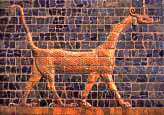
Marduk’s dragon
with serpent head, leonine front feet, avian hind feet, and
scorpion’s tail. Though distinguished from Tiamat, neither
can it be entirely separated from Tiamat. |
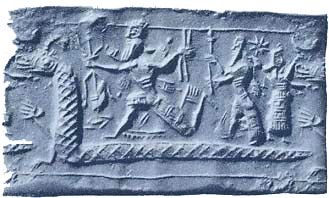
Babylonian cylinder
seals depicted the subdued dragon as the vehicle or carrier of the
god,
a common theme in the
ancient world.
The protagonist in this
narrative is the god Marduk. When all else had failed, it was
Marduk
who rose to confront Tiamat and her companions. The god took
possession of his "matchless weapons" and:
In front of
him he set the lightning,
With a blazing flame he filled his body.
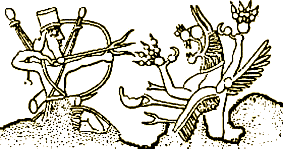 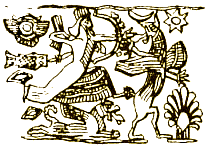
In the Babylonian
cylinder seals above, the thunderbolt of Marduk appears as an arrow
launched against Tiamat.
The “trident” form of
the arrow/thunderbolt is a mystery yet to resolved by specialists.
Mounted on his
storm-chariot and turbaned with a "fearsome halo," the god set his
course toward the raging Tiamat. On the approach of
Marduk, the
dragon-goddess was "like one possessed; she took leave of her
senses. In fury Tiamat cried out aloud…"
Then joined
issue Tiamat and Marduk, wisest of gods,
They swayed in single combat, locked in battle.
The lord spread out his net to enfold her,
The Evil Wind, which followed behind, he let loose in
her face.
When Tiamat opened her mouth to consume him,
He drove in the Evil Wind that she close not her lips.
As the fierce winds charged her belly,
Her body was distended and her mouth was wide open.
He released the arrow, it tore her belly,
It cut through her insides, splitting the heart.
Having thus subdued her, he extinguished her life.
He cast down her carcass to stand upon it.
After he had slain Tiamat, the leader,
Her band was shattered, her troupe broken up.

|
In this way Marduk
vanquished the dragon and her brood. Upon his victory the god
established a new cosmic order, the body of the dragon providing the
raw material for a great city of the gods.
In their annual Akitu festival the Babylonians reenacted both
Tiamat’s attack and the god Marduk’s
subjugation of the monster. Commemorative rites such as these were,
in fact, the model for ancient New Years celebrations throughout the
Near East, with numerous counterparts amongst ancient cultures the
world over, all harking back to the primeval destruction and renewal
of the world.
The Myth of the Divine Thunderbolt
A thunderstorm can be a terrifying event. The lightning .ash and
thunderclap may indeed awaken a primal fear, perhaps instilling a
newfound empathy for the mythmakers of antiquity. In the presence of
a thunderstorm, was it not natural for our ancestors to envisage
lightning-beasts roaring in the heavens or celestial armies hurling
lightning-spears across the sky?
Common
suppositions have prevented investigators from examining
the underlying patterns of lightning symbolism.
Cross-cultural comparison reveals numerous global images of
lightning in ancient times, but these are a far cry from the
phenomena we experience today. The lightning of the gods
altered the order of the heavens and changed planetary
history. |
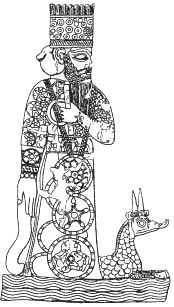
Statue of the
god Marduk with his dragon.
|
|

The Babylonian
seven-headed dragon, a familiar but enigmatic theme in
ancient times. |
Ancient
chroniclers employed a wide range of natural and manmade
symbols to describe the cosmic "thunderbolt." The breadth of
images will make no sense until we find a new vantage point,
one permitting us to discern the archetype, the original
form that preceded the symbols and gave them their
mythological context. Terrestrial lightning was but one of
many hieroglyphs used to describe the celebrated weapon of
gods and heroes.
Here the
distinction between archetype and symbol becomes crucial.
Viewed in isolation from the archetype, the symbol presents
blatant contradictions; when illuminated by the archetype,
it acquires integrity. |
|
The symbol can then be
seen in reference to something once visible in the sky, but no
longer present. From this new vantage point, the investigator can
subject the implied human experience to rational and scientific
tests.
To confront the symbols under discussion is to meet the deepest fear
of humanity, the Doomsday anxiety, the expectation that a prior
world-threatening disaster will occur again. Doomsday arrived
suddenly and without mercy, and across the millennia the memory of
catastrophe haunted every culture on earth.
The historic impact of
the memory is, in fact, evidence for the events implied by
cross-cultural testimony. As remarked by the Greek poet Sophocles,
the thunderbolt of Zeus always meant disaster:
the terrifying bolt "never shoots forth for nothing, nor without
catastrophe."
To offset this anxiety, each tribe or nation cherished its own
account of the ancestral warrior, the bearer of lightning and
thunder and the victor in the primeval contest. The combat story,
told in thousands of variations, gave the early cultures their
celestial models for war and defense.
Through ritual and
symbolic imitation, cultures sought magical protection against
chaos. Thus, the narratives, symbols, pictures, hymns, rites, and
commemorative monuments offer countless clues as to the nature of
the upheaval and the magical “weapons” featured at the most
critical juncture.
What were the
thunderbolts of the gods?
To illustrate the scale of the enigma, we list below seven of the
most common lightning themes recurring from one culture to
another—images too specific, too peculiar, and too widespread to be
rationalized as mere exaggerations or make believe.
The symbols direct our
attention to natural phenomena far more powerful and more terrifying
than anything occurring in our own time:
-
Motif #1:
Hero’s Weapon. Lightning takes the form of a frightful
sword, arrow, axe, flail or other weapon in the hands of
a great warrior or divine messenger—a god whose identity
merges with the lightning-weapon itself. Surprisingly,
the same "weapon" turns up as an instrument of healing
or resurrection as well.
-
Motif #2:
Winged Thunderbolt/Winged Disk. Lightning appears as a
radiant disk or sphere in the sky, with heaven-spanning
wings. It is a great "thunderbird," or it is launched
from the wings of such a bird, or bursts forth as a .ash
of .re from its eye.
-
Motif #3:
Axis Mundi. Lighting streaks along the world axis,
acquiring the form of a towering column that is said to
have "separated heaven and earth" in primeval times.
This same pillar is the hero’s staff, rod, or scepter,
and through metamorphosis it passes into other, more
complex forms as well.
-
Motif #4:
Lightning Wheel and Flower. Lightning "blossoms" as
radiating, symmetrical streamers—the petals of a
luminous flower, the aweinspiring "glory" of a great
star, or the spokes of a cosmic wheel turning in the
heavens.
-
Motif #5:
Whirling Thunderbolt. Lightning spirals into serpentine
coils or winds upward in a helical motion around a
central, axial column. It whirls across the heavens as a
celestial tornado, whirlwind, or whirlpool, sometimes
graphically recorded as a whorl, swastika, or triskeleon.
-
Motif #6:
Caduceus. Lightning manifests as entwined serpents,
ribbons, or .laments whirling upward along a central
axis or column. Two entwined .laments signify the
lightning-form taken by cosmic twins.
-
Motif #7:
Thunderstones. Lightning arrives with falling stones or
boulders. Typically, the falling rocks are flung by
warring gods who also brandish, or are, the divine
thunderbolt.
How did such images of
the "thunderbolt" take root around the world? Though the global
images have almost nothing in common with lightning today, the
cross-cultural patterns are remarkably consistent. Hence, a solution
to the mystery must be possible. |
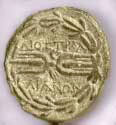 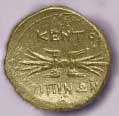 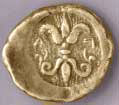 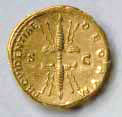
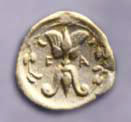 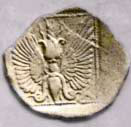 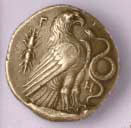 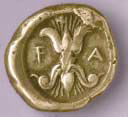
Greek coins
shown on this and following page depict the thunderbolt of
Zeus with many variation Yet certain patterns stand out, a
none seem to suggest the famil form of lightning today.
|
Thunderbolt as
Divine Weapon in Primeval Times
Though we cannot pause here to elaborate all of the themes noted
above, each will find comprehensive treatment in these monographs.
As for the first motif on our list—the legendary hero’s weapon—most
mythologists assume that the association with "lightning" is a
secondary principle, not a general rule. Our contention, however,
is that virtually all forms of the hero’s weapon belong to the
thunderbolt motif. A unified explanation of the magical sword,
arrow, spear, club, or axe is possible, even in instances where the
explicit "lightning" identity was lost over time. At the heart of
the theme lie the natural formations taken by plasma discharge.
In the course of our analysis we intend to show that the essence of
the divine thunderbolt was etheric—it was wind, water, and fire. It
was a whirlwind or tornado, a whirling flame, a devastating flood,
even a comet. If it was also a celestial serpent or winged monster,
that was because the plasma discharge formations appearing above the
ancient witnesses readily inspired such fabulous interpretations.
It is the earlier images that illuminate the later fragments and
elaborations of the thunderbolt motif. In the Babylonian narrative
above, the arrow released by Marduk is the god’s thunderbolt.
Elsewhere, the god’s bolt appears as a lance, a weapon by which the
god himself was represented in Babylonian iconography.
One of the
texts also explains that the firebrands kindled as part of the
festivities represented the god’s lightning-arrows.
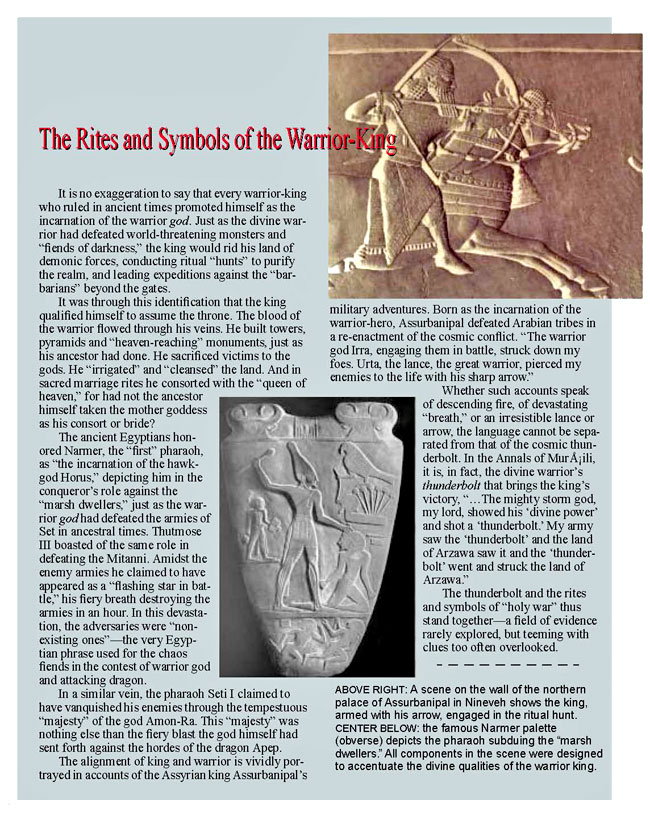
On the face of it, the
symbolism may seem perfectly natural in reference to familiar
lightning. But enigmatic nuances of the thunderbolt stand out in
both the Babylonian written narratives and the ritual reenactments
of the event.
Marduk’s weapon appears to overlap with the image of a
whirling "cyclone" called abubu and rendered pictographically as a
mace or club—images that make little sense in themselves but will
take on increasing clarity in the course of our investigation.
|
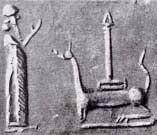
The dragon of
Marduk carries the symbol of his vanquisher—the
lightning-weapon—on his back. |
Similar images
occur in Sumerian accounts of the great warrior
Ninurta’s
victory over the monstrous “bird” Anzu who, like
Typhon, had
sought to usurp the powers of heaven. On the mountainside
Anzu and Ninurta met …Clouds of death rained down, an arrow
flashed lightning. Whizzed the battle force roared between
them.
By his victory, Ninurta became the “strong warrior
who slays with his weapon,” his lightning arrow or dart
having pierced the heart of the monster. So too, the
Assyrian “storm god” Adad (Phoenician and
Hebrew Hadad), an
alter ego of Marduk, is shown wielding thunderbolts as
arrows or spears, though elsewhere he carries a lightning
mace (right).
The great
Assyrian warrior Ashur launched arrows from his bow as
lightning, in the very fashion of the Babylonian Marduk.
As noted by Mircea Eliade, the Hebrew Yahweh "displayed his
power by means of storms; thunder is his voice and lightning
is called Yahweh’s ‘fire,’ or his ‘arrows." The connection
is deeply embedded in the language. The Hebrew baraq,
‘lightning,’ is also used in the sense of ‘flashing
arrow-head.”
Similarly, the
feared "sword of God," according to Louis Ginzberg, is the
flashing light-ning. Various Christian traditions appear
to have adapted the idea to later images of God's struggle
with the "devil." In the legends of Armenian Christians, for
example, "the lightning is often a sword, arrow or fiery
whip which the Lord is hurling at the devil, who is fleeing,
and who naturally and gradually has taken the place of the
ancient dragon."
Few scholars have found any of this to be
enigmatic. The fundamental idea may seem so natural that
most translators of ancient texts give little attention to
the unique attributes and associations of the thunderbolt.
One fact
relating to the evolution of world mythology is frequently
overlooked, however: the setting of later stories
progressively changed as the gods were brought down to
earth. In the course of Egyptian history, for example, both
the creator Ra and his regent Horus, whose original domain
was undeniably celestial, came to be remembered as
terrestrial kings.
In later time, when Greek and Roman
poets, philosophers, and naturalists sought to gather
knowledge from far flung cultures, Egyptian priests would
relate to them many stories of the gods, declaring that the
events had occurred in their own city in the time of the
"ancestors."
As a bridge between the more archaic world and the fragmented and
diluted myths of later times, Greek accounts offer many clues as to
the evolution of thunderbolt symbolism. In the hands of the
sovereign Zeus, the nature of the divine weapon is clear.
The poet
Pindar speaks of Zeus "whose spear is lightning," while
Aristophanes invokes lighting as "the immortal fiery spear of
Zeus." In the words of Nonnus, Zeus is "the javelin-thrower of the
thunderbolt." "The spear he shook [in the battle with Typhon] was lightning." "Do thou in battle lift thy
lightning-flash, Olympus’ luminous spear." |
|
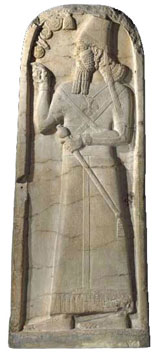
Assyrian “storm
god” Adad holds in his hand a mace, a form taken by the
lightning of the gods. |
|
The connection
is transparent in the Greek keraunós, “thunderbolt,” most
commonly used for Zeus’ weapon and said to stem from a
Proto-Indo-European root *ker-.
The same root appears to lie behind the Sanskrit _áru-,
‘arrow’ and the Gothic haírus, ‘sword.’ As in other
cultures, the Greek thunderbolt also
found frequent expression as an arrow.
The most familiar
representations of the "eagle" of Zeus (as, of course, the
eagle of the Latin Jupiter) depict the god’s lightning as
arrows held in the talons of the bird—a representation well
preserved into modern times by the symbol of the eagle and
its lightning-arrows on the U.S. one dollar bill. Many
authorities thus acknowledge that the lightning of the gods
found expression as an arrow in plastic art of Greece,
Italy, and Sicily.
But as we descend to secondary gods and regional heroes, the
connection of weapon and thunderbolt becomes more ambiguous.
The Homeric Hymn to Pythian Apollo describes the god’s
confrontation with the chaos serpent Python, whom the
chroniclers identified alternately as a form of the dragon
Typhon or as the nurse of Typhon.
Significantly, we do not
find in the poet’s words any explicit acknowledgment that it
was a lightning-weapon that brought down the serpent. The
Homeric and other accounts refer to the invincible "arrow"
launched by Apollo, causing the monster to shudder violently
and to give up its life in a torrent of blood.
But was this
"arrow" just an arrow, or did it really mean the
thunderbolt
which, in the earlier Near Eastern accounts, took the form
of an arrow?
Many authorities have, in fact, recognized that the arrows
or swords of Apollo cannot be separated from the language of
the thunderbolt.
Apollo bore the epithet
chrysáoros or
chrysáor—meaning “of the Golden Sword” (áor)—and here the
lightning connection shines through: according to the
distinguished authority, W. H. Roscher, the Golden Sword is
a Greek hieroglyph for the thunderbolt.
Indeed, Zeus
himself, the most famous wielder of the thunderbolt, was Chrysaoreús or
Chrysaórios, "He of the
Golden Sword." |
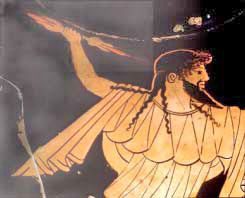
Zeus launching
his thunderbolt, from a Greek vase painting.
|
|
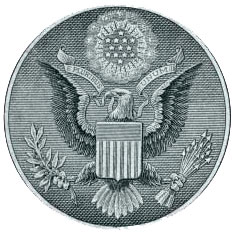
The eagle on he
U.S. one dollar bill holds in its talons an olive branch and
a sheaf of arrows, the latter tracing to classical images of
the eagle of Zeus (Latin Jupiter) with its lightning-arrows. |
 
The two paintings above, both depicting Apollo’s defeat of Python,
accent the ambiguity as to the mythic setting.
The painting on the
left, by J. M. W, Turner, suggests a terrestrial occurrence,
while
the painting by Eugène Delacroix on the right has preserved many
nuances of the original celestial context.
Cross cultural
comparison makes clear that the hero’s connection to the
"thunderbolts of the gods" was no accident. We are not dealing
simply with a poetic metaphor for ordinary lightning. Rather,
ordinary lightning served as a metaphor for something once seen in
the sky, but alien to ordinary experience. Lightning thus stands
alongside other metaphors (arrow, sword, whirlwind, comet, etc.),
all pointing to extraordinary experience.
The archetypal identity
of the warrior-hero’s weapon can be brought to light only by finding
the root forms expressed in a wide array of symbols.
|
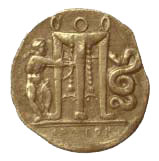
Scene on a Greek coin illustrates Apollo’s confrontation with the
serpent Python. |
What occurred in the case of
Apollo is underscored by many parallels
in the language and symbolism of legendary heroes. By following this
evolutionary tendency across the centuries, we observe how the poets
and historians placed the stories on a landscape familiar to them,
as the thunderbolt became a sword, spear, hammer or club of a
celebrated warrior, now a “great man” who continued to battle chaos
monsters, but no longer in the heavens.
The celestial warrior lost
his cosmic attributes to become the best of heroes, the esteemed
ancestor of the tribe or nation telling the story. Once reduced to
human dimensions, the hero could no longer hold
onto his original weapon, a weapon claimed to have shaken and
forever changed both heaven and earth.
The evolution of the myth presented an enigma. How would later poets
and historians, after localizing the stories, describe the cosmic
weapon with which, in the more archaic tales, the warriorgod
vanquished heaven-spanning serpents, dragons, and chaos monsters?
|
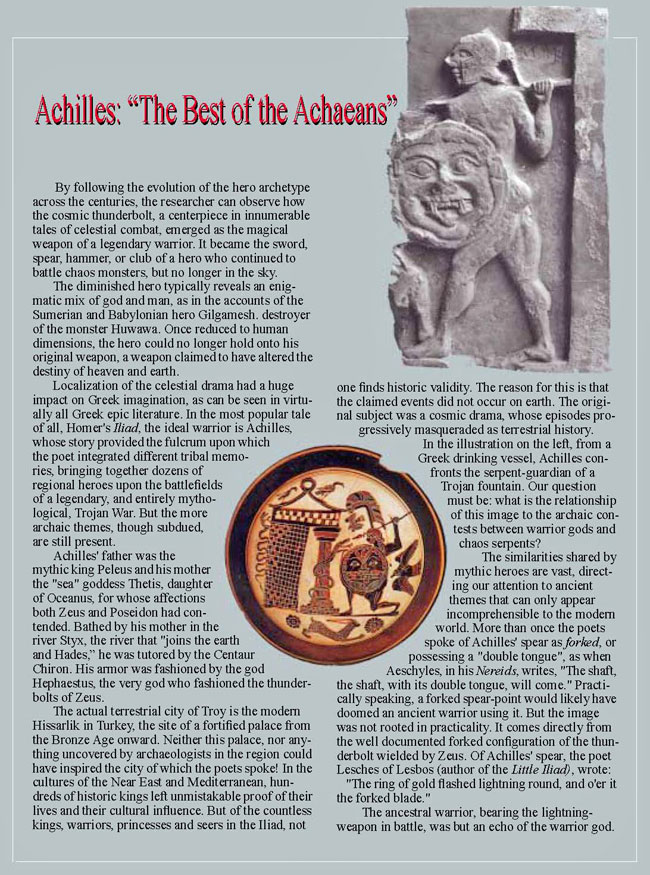
Of course, mythologists
will not normally think of the sword of Perseus, or
the club of Heracles—much less the healing "staff"
of Hermes—as symbols of the cosmic "thunderbolt."
World mythology presents such figures by the thousands, and in
virtually all of these instances the original identity of the
magical weapon has slipped into the background.
Yet only rarely
could it be hidden entirely. In most cases, the localized weapon
still retained glimpses of the original: it was a "gift" from gods
or goddesses, could strike like lighting, or was constructed from
"flashing" gold or some indestructible material, or possessed
magical powers tracing to an age of gods or semi-divine ancestors.
|
Nevertheless, what we
usually see is just a shadow of the cosmic thunderbolt so
vividly described in early Near Eastern narratives of primeval order
and chaos. The “shadow,” however, is sufficient to establish
the original identity of thunderbolt and hero’s weapon in other
bodies of myth.
In the Grail cycle of myths, lightning receives the name
Lanceor, or "Golden Lance," an archaic name
of Lancelot. Lightning is also linked to the sword
Excalibur, which Geoffrey of Monmouth called
Caliburn, from the Welsh Caledvwich, Irish
Caladbolg: old names for the lightning.’
The most famous Celtic hero, Cúchulainn, victor over
chaos powers, held a weapon granted him by the lightning god Bolga, "the inventor of the missile spear."
By acquiring
this weapon, "Cúchulainn was greatly strengthened in
battle." Gaé Bolga is translated as “Bolga’s spear” or
“a harpoon-like javelin.” Sometimes referred to as a “lightning
weapon,” it had its origin in the Otherworld where it was forged
by the divine smith. Its lightning stroke was always fatal.
|
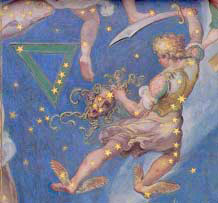
Perseus, the hero who slew the monstrous Medusa, was celebrated in
later times as a constellation. The scene here is from the masterful
work painted on the ceiling fresco of the Villa Farnese in Caprarola,
Italy.
|
In the form of a sword,
the lighting weapon bestowed upon Fergus, one of the two sons of
Fionn, offered a great advantage in warfare, enabling him
(like so many mythic heroes) to single-handedly slay hundreds on the
battle field.
"This sword was named In
Caladbolg, a
two-handed lightning sword."
|
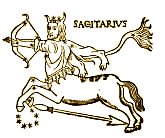
Sagittarius. From Hyginus, Poetica astronomica (1485 edition).
|
Again and again, Germanic tribes placed a lightning weapon in the
hands of their celebrated heroes. The diverse mythic forms of the
thunderbolt, according to H. Bächtold-Stäubli, include,
"the glowing
missiles; as such they are present in all stages of human cultural
history, from the rough stone and club of primitive times through
the hammer, axe, and spear, to the golden sword wielded by the
Hero."
Gertrude Jobes, a diligent investigator of symbolic themes, affirms
that, among the Altaic Tatars, lightning was the "arrow of a mighty
hero." A common Slavic name for the weapon of the celestial
warrior Perun is strela, "arrow." The lightning of the
Finnish Ukko appears as "fire arrows" or "copper arrows."
Similarly, the
Finnish warrior-hero Jumala, is said to have "wielded thunderbolts
in the shape of jagged lightning-spears."
|
In several parts of Italy
saetta or arrow is the name for the
lightning. In Slavonia the “thunderstone” is called strelica (i.
e., arrow), on Swedish soil in some places åskpil (thunder-arrow),
in Mecklenburg dunnerpil, etc.
The same language appears in the British Isles. Irish saign_n,
“lightning,” is derived from saigit, “arrow,” and both this word and
seah, “thunderbolt,” in Breton dialects are based on Latin
sagitta,
“arrow.” Thus our familiar images of Sagittarius, the divine
"Archer" of constellation symbolism, clearly belong to an ancient
tradition equating the hero’s arrow and the divine thunderbolt. Less
known is the much smaller constellation Sagitta, "the Arrow," close
to the center of the Milky Way. Here the constellation symbol,
according to Eratosthenes, harked back to "the arrow shot by
Apollo
against the Cyclops, who forged the lightning with which
Zeus had
cut off the life of his son Asclepius."
Among the Tibetans and Mongols lightning is seen as the arrow of a
dragon-riding god, and thunder as the voice of the dragon. So too,
the warrior Raiden, in Japanese myth, wielded
"fire-arrows"—acknowledged to be lightning—in his battle against the
chaos power, Raiju, the "Thunder-beast."
Among the Zulu tribes of Africa, lightning takes the form of a
dazzling spear hurled through the air. The African Gikuyu say that
God clears his path with a weapon, often described as a sword, and
identified as the lightning. And amongst the ancient Egyptians,
such divine weapons as the spear, harpoon, and .ail, employed in the
warrior Horus’ battles against chaos, have been identified with the
thunderbolt.
|
Numerous equations of hero’s weapon and thunderbolts occur in the
Americas as well. An Iroquois account tells of a warrior
Hé-no’s whose thunderbolt vanquished a chaos
monster:
Hé-no’s name means ‘thunder.’ A monstrous serpent dwelt under the
village, and made his annual repast upon the bodies of the dead
which were buried by its side … he went forth once a year, and
poisoned the waters of the Niagara, and also of the Cayuga creek,
whereby the pestilence was created … Hé-no discharged upon the
monster a terrific thunderbolt which inflicted a mortal wound.
Essentially the same
notions prevailed throughout the Americas. The Navaho say
that, long ago, the arrows that defeated the devouring powers of
chaos were the lightning. Zuni tradition identifies the
lighting as "as the arrows of celestial Archers." |
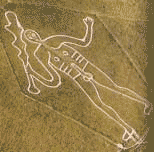
In a field at Cerne Abbas, England, the Celtic hero god Dagda is
inscribed in chalk. Wielding a giant club, the figure is almost 220
feet tall. |
The Pawnee and
their neighbors recall the great warrior, named Black Lightning
Arrow. Thus, Von del Chamberlain, who ranks among the most
informed authorities on Plains Indian mythology, tells us
that,
"the flint-tipped arrows of the Indian correspond to the lightning arrows
shot to earth by higher powers …Pueblo Indian designs also
show the lightning, tipped with arrow-heads."
Thunderbolt as Club, Hammer, and Axe
The warrior and his thunder-weapon find explicit illustration in the
Germanic Thor, whose name is given to a day of the week—
Donnerstag,
the day of Thunder, our Thursday. He was the strongest of men and
of gods, the victor over giants, dragons and a host of dark or
destructive powers. Thor was the "Hurler" (Vingnir) and his weapon
was the thunderbolt, with which the great warrior himself seems to
have been inseparably identified. "The god is, etymologically,
thunder, and his hammer, Mjöllnir (Crusher), represents
lightning."
As we should expect, it was Thor who vanquished the terrible serpent
Midgard or Jormungand ("wolf-serpent"), seen thrashing about in the
sky while the world reeled under the catastrophe of
Ragnarok, the
rain of fire and gravel. In confronting the monster, Thor hurled his
great stone hammer or mallet Mjöllnir, fashioned by dwarves in much
the same way that the Cyplopes fashioned the thunderbolt of
Zeus.
The power of the blow was sufficient to send Midgard plummeting into
the sea.
Again, both the symbolic associations and the linguistic roots bear
out the overlapping identities of hero, hero’s weapon, and
lightning. It is generally recognized that Thor’s "lightning weapon"
was originally an independent warrior-god.
Amulets dated to the
tenth century and presenting the lightning-weapon in human-like
form, sometimes show the lightning god’s beard taking the place of
the hammer head.
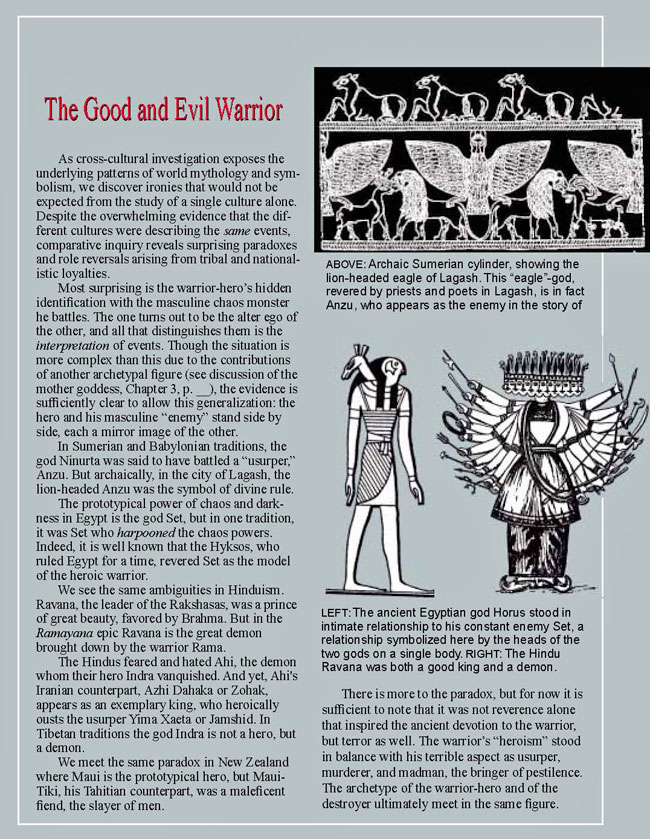
Numerous authorities including
Jacob Grimm assures us that the
hammer of Thor means the "crushing thunderbolt."
Grimm also
compares the Teutonic Mjölnir with Slavic molnija, "lightning."
|
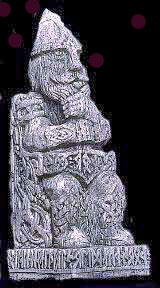
Norse warrior god Thor, wielder of the thunderbolt in battle.
|
In
fact, the widespread linguistic relationship of the stone
hammerhead to lightning is now well-established. Welsh mellt,
Church Slavonic mluniji, Serbo-Croatian munja, Russian
molnija and
Old Prussian mealde, all meaning "lightning," are derived from the
same root.
So too, the Old Norse myln, "fire," and especially Latvian
milna, are invoked as the "hammer" of the warrior
Perkun and
acknowledged to be the lightning. Scholars such as Christopher Blinkenberg who have investigated the general theme. Find that the
identification warrior’s “hammer” with lightning is so pervasive as
to constitute a bedrock principle.
Also of interest here is the Hindu vajra, the illustrious
thunderbolt of the warrior Indra, called a "whizzing club" in the
sacred texts of the Rig Veda. Such images of the lighting-weapon
invariably lead us backward to the lightning-mace held in the hands
of the Near Eastern storm gods noted above.
To these symbols of the divine thunderbolt we must add the axe
wielded by gods and heroes—a subject already well explored in
scholarly studies.
As noted by B Schmidt, the word for the
thunderbolt in modern Greek
tales of modern tales of primordial warfare in the heavens is astropeléki, the "sky axe," though perhaps ‘star
axe or stellar axe’ comes closer. This is the very term which, to this day, native
populations use for Neolithic stone fragments and implements that,
when recovered, are venerated as the lightning weapons of the gods.
|
Authorities who have examined the symbolism of the
lightningaxe
trace it back to Minoan civilization and farther back to
Babylonian
cosmology. But the lightning-axe is not limited to a particular
region of the world. It appears as the weapon of the Aztec Tlaloc,
the Maya Chac, and numerous legendary warriors of African
mythology, finding equally vivid expression in the South Pacific and
throughout eastern and southeastern Asia.
The Club of Heracles
|
Of all the ancient Greek heroes, none achieved greater popularity
than the club-wielding warrior Heracles (Roman Hercules), whose
far-famed “Twelve Labors,” together with many other adventures,
compressed diverse tribal lore into the ordeals of a single hero.
The vase painting on the following page depicts Heracles’ defeat of
the giant sea serpent Triton. Such exploits typified the biography
of the hero, with its variations on a single underlying theme, all
harking back to the mythic warrior’s contests with chaos monsters.
Heracles’ own relationship to the thunderbolt may not be
obvious, but neither was it forgotten. As seen on the previous page,
a Greek coin depicts Heracles standing with a club in
his right hand. In the field behind him is the thunderbolt of Zeus. Just as the spear of the celebrated warrior Achilles retained the connection to the thunderbolt of
Zeus, the poet Hesiod describes Heracles leaping
into battle "like the lightning of his father Zeus.”
|
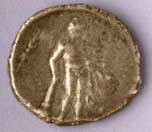
In this scene on a Greek coin, Heracles wears a lion skin over his
left arm while his right hand rests on a club; in the field to the
left, a thunderbolt. |
|
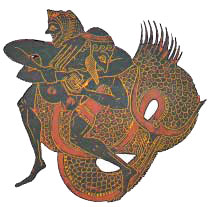
Heracles vanquishes the seadragon Triton.
|
In view of
Heracles’ acknowledged links to Thor
and Indra, it would make no sense to ignore
the cross-cultural implication, that Heracles’
giant-slaying club is a Greek variant of the lightning
weapon carried by heroes around the world. Of course,
most specialists in Greek literature and religion give
little attention to cross-cultural comparison. But the
lightning-clubs of other heroes globally can hardly be
ignored.
Even the Dinka of Sudan
honored a great ancestor-god Deng, whose club
was the thunderbolt.
Cosmic Thunderbolt and Plasma Discharge
The mythic traditions reviewed above pose a question vital to our
investigation. What is the cosmic thunderbolt’s connection to the
plasma discharge forms documented in the laboratory and found in
rock art by Anthony Peratt?
|
|
The evidence
suggests that before the monumental civilizations arose,
intense electrical activity in the sky was the overriding
concern of humanity.
The events that inspired the myth-making
epoch, with its pervasive themes of order and chaos, also provoked a
massive collective response within all of the emerging
civilizations.
Both the natural events and the commemorate symbols
they inspired bear a direct relationship to the vast pictographic
record carved on stone, pointing back to a time when all of humanity
witnessed prodigious plasma formations in the heavens.
The illustration on page 30 shows the Sumerian Ninurta wielding the
thunderbolt in his battle with the monster Anzu. For our purpose
here, the key is the form of Ninurta’s thunderbolt
(right).
We
present alongside this image a three-dimensional representation of
the corresponding discharge form suggested by the archaic symbol. It
is a variation on the “hourglass” configuration discussed in
Chapter One. We offer this idealized configuration to emphasize
that, in the plasma interpretation of the thunderbolt, the two outer
“prongs” belong to the same transparent, cylindrical current sheet.
The “warped” look of the cylindrical component of the “hourglass”
configuration can be compared to many variations in archaic rock
art.
|
LEFT: Thunderbolt in the hands of Ninurta, as he battled the monster
Anzu.
RIGHT: Idealization of a bi-polar plasma discharge formation,
illustrating the three-dimensional structure accounting for the
Babylonian image. |

ABOVE: Recurring Greek images of the thunderbolt of Zeus.
Of all the ancient cultures it seems that the Greeks preserved the
most voluminous artistic renderings of the thunderbolt. It is
instructive, therefore, to compare the core Greek images to similar
variations in laboratory discharge configurations.
|
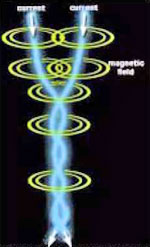
The current flow in an axial discharge column typically conforms to
this illustration of entwined Birkeland Currents. |
The examples above represent several common
thunderbolt forms in
Greek art. But it is the three dimensional nuances of the plasma
discharge interpretation that enable us to see past the limitations
of the ancient media and to envision the energetic patterns
represented. The Greek themes then fall into place.
In art and literature, the Greek thunderbolt repeatedly shows a
central “corkscrew” column, answering to Birkeland Currents entwined
around a central axis (illustration on the left). In Greek
representations this corkscrew column persists through many
variations of the thunderbolts, just as it does in similar
laboratory discharge configurations.
As the entwined currents in a linear discharge become more tightly
bound they may appear as a single glowing column, a principle
evident in many Greek illustrations. Indeed, the Greek examples
leave no doubt that this axial column is the thunderbolt as sword,
spear, missile, or arrow (examples below).
From any conventional vantage point, the Greek thunderbolt images
can only appear to be disconnected from all natural experience. A
hallmark of the Greek images is the role of symmetry, both along the
axis and to the left and right of the axis—not a feature of familiar
lightning, but a feature remarkably consistent with the patterns of
plasma discharge.
|
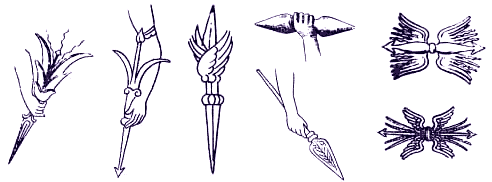
Greek
thunderbolt as sword, spear, missile, or arrow.
|
Greek artists repeatedly show the twisted column sending forth the
sepals or leaves of a “lotus”-blossom, these evolving into
symmetrically displayed, outstretched horns or wings. Hence, the
general accord with plasma discharge configurations is all the more
telling (example on right).
Typically, the Greek images depict either the lotus-form or its
evolution into horns or wings in bi-polar pairs—much like many rock
art images associated with the hour-glass form (the “squatter man,”
etc.). Greek examples of the thunderbolts are dominated by patterns
of bi-polarity, often with perfect symmetry.
But the artists also
employed frequent variations between the upward-and
down-ward-pointing components, while only rarely varying the
symmetry to the left and right of the axis. We have already noted
similar variations in the vertical components of the hour-glass or
“squatter man” in worldwide rock art. (See discussion of bi-polar
symmetry in Chapter One.)
|
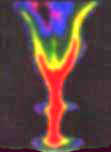
Laboratory discharge photograph published by Anthony Peratt.
|
The laboratory counterpart of form above-right, was published by
Anthony Peratt in his first article on plasma discharge in relation
to ancient rock art. The idealized form of the discharge, given for
the purpose of illustrating three-dimensional structure and plasma
dynamics, is formation (A) below.
In this “brandy glass” formation,
the upper termination of the axial discharge column appears as a
central spike enclosed within “horns” or outstretched “wings.”

The
illustrations above interpret the Greek thunderbolt images as plasma
discharge,
emphasizing the three
dimensional contribution of current sheets and cylinders.
|
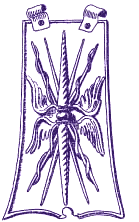
This later image of the Greek thunderbolt integrates key design
elements from the more archaic designs, retaining the principles of
bipolar symmetry and symmetry to the left and right of the axis. The
parterres are entirely alien to those of a terrestrial lightning
bolt. |
Plasma discharge generates magnetic fields that, in turn, influence
the discharge structure and evolution. Current filaments and sheets
can attract each other at larger distances but repel at shorter
distances, leading to various forms of equilibrium, all contributing
to the non-random or “organized” look of the configurations.
The forms noted here graphically idealize the plasma discharge
formations implied by the Greek images. Along the axial column,
“pinching” of the entwined Birkeland Currents by the induced
magnetic fields will typically produce a spheroid, which then
begins to flatten into a disk. As the disk expands, its edges will
begin bending upward or downward to form a “saucepan” or “bowl”
shape. It is this spheroid-to-disk and disk-to-cylinder evolution
that gives rise to the “brandy glass” forms (A) and (B) above.
A discharge column can produce multiple disks or toruses stacked
along the column Where conditions foster bi-polar symmetry, it is
not uncommon for one disk above the pinch point to bend upwards
while the disk forming beneath the pinch bends downwards, creating
the hour-glass form discussed in Chapter One.
In high energy
discharge an entire stack of disks or toruses may be bent in either
direction, a form also noted in Chapter One.
It is important to see the discharge configuration in its
three-dimensional aspects. An observer walking around the
configuration would continue to see essentially the same form.
And
while the configuration displays three prongs (a “trident” form),
the central column, composed of bound currents, is of a
fundamentally different dynamic than the two “horns” of the right
and left, which belong to a single rotating (cylindrical) current
sheet.
|
|
In the second
illustrated configuration (B), the spheroid-in-formation
of (A) has begun to flatten into a disk, and the central column of
the discharge has extended farther upward into the “brandy
glass” form of the current sheet.
In image (C) the disk in the discharge column has moved upward and
its edges have folded upward as well, to influence—and be influenced
by—the magnetic fields configuring the upper “horns.” The “horns”
have become more angular, a common occurrence in the evolution of
Peratt Instabilities.
Image (D) illustrates the interaction of embedded cylindrical
currents held in equilibrium (attraction and repulsion) parallel to
the discharge axis. This “pitchfork” appearance answers to the Greek
form (6) and to the laboratory discharge configuration given on the
right. |
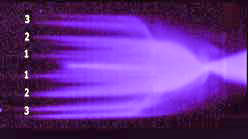
Laboratory
discharge, in artificial color, illustrates the “pitchfork’
configuration, constituted of cylindrical current sheets in
a plasma pinch. |
In image (E) the cylinders of (D) are magnetically pinched at their
base to form embedded conical cylinders. This is the basis for the
discharge interpretation of the Greek form (7).
All of these configurations have one attribute in common. Turn them
on their axes, and they would continue to present essentially the
same form. The distinctive appearance is due to the luminosity of
excited particles along the observer’s lines of sight. In the
cylindrical components, for example, the greatest brightness occurs
on the limbs, where the line of sight passes through the largest
volume of excited particles, whereas the more transparent or darker
regions are those where the line of sight passes through the lowest
volume (the portion of the cylinder perpendicular to the viewer).
Analogs in Space
It is not in the laboratory alone that we observe the unique
features of plasma discharge discussed here. The same formations
can now be seen in space, though most astronomers remain unaware
that electrified plasma generates these observed forms. Of course,
the electrical interpretation of the nebulas noted here is not the
commonly accepted view among astronomers. Thus, as new telescopes
further our ability to see deeply into space, a continuing stream of
surprises seems certain.
|
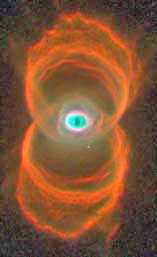
The Hourglass Nebula offers a useful demonstration of the discharge
configuration under discussion. |
The “hourglass” discharge configuration has one of its more obvious
counterparts in the Hourglass Nebula on the left, and astronomers
concede that it is forcing a reconsideration of the physics of
nebula formation. According to Raghvendra Sahai, an astronomer at
the Jet Propulsion Laboratory in Pasadena, California,
"What we
thought we understood of planetary nebulae we no longer do.
Something different and dramatic is going on."
Astrophysicists
offer various guesses as to how a belt of “gas and dust” might form
around the equator of a dying star. They imagine that a stellar
“wind”—exploding in all directions—is somehow “constricted” to
create bipolar jets. In some discussions of late, they even use the
term "pinch," but in contexts that are more gravitational and
mechanical than electrical. No mention is made of the far simpler
plasma discharge pinch, because that requires a source of electrical
energy external to the star. Yet in plasma laboratory experiments,
the observed effect is commonplace—not just the pinch but all of the
features of "hourglass" formations now seen in space.
A similar mystery is posed by the Butterfly Nebula (or
M2-9), and
higher resolution Hubble Telescope images have only underscored the
unanswered questions. Inside the "hourglass" of both the
Hourglass
and Butterfly nebulas is a second hourglass form.
|
"It’s very hard to see
how you get it," Sahai states. But again, glowing coaxial
cylinders and cones are not a surprise to experts in plasma
discharge phenomena. Responding to the surprising details of the Hubble image,
Lars
Christensen of the European Space Agency states:
"It’s a big
mystery to us all—how a round star like our own sun can create this
effect, which is so symmetrical. It’s amazing."
|
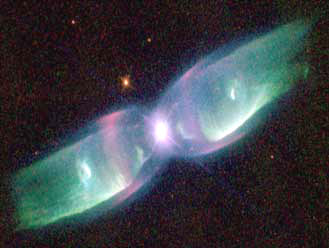
Hubble Telescope image of the The Butterfly Nebula, one of the most
striking examples of a bipolar formation in space, with collimated
jets and embedded cylinders extending distances greater than the
diameter of our |
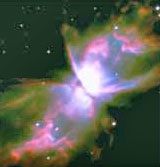
This image produced by the Very Large Telescope, focused on the
pinch point at the hourglass “neck” of the Butterfly Nebula. It shows
a toroidal band of dusty plasma occluding the star at the center of
a high energy discharge. A torus of this sort, whether visible or
not, is predicted by the science of plasma discharge.
|
Struggling to comprehend things never anticipated by prior
theoretical models, astronomers have resorted to improbable guesses
based on gravitational and mechanical, non electric forces with no
reference to the electrical circuits necessary to generate the
observed magnetic fields. Some imagine a binary star system with two
stars in extremely close proximity exchanging mass. Matter drawn
from one of the stars, they suppose, generates a giant disk around
the other. Then,
“the high-speed wind from one of the stars rams
into the surrounding disk, which serves as a nozzle. The wind is
deflected in a perpendicular direction and forms the pair of jets
seen in the nebula’s image.”
This scenario, using a “jet engine”
as its analogy, lacks any
plausible mechanism to generate the high-speed wind in the first
place. Moreover, the claimed “wind” should generate highly visible
effects on the disk, causing it to quickly dissipate. Both the
“hourglass” and “pitchfork” components of the nebula are, in fact,
replicable in high-energy electric discharges. Illuminated by
direct experimental evidence, the Butterfly Nebula can be seen as a
“thunderbolt” form in space, with powerful electromagnetic forces
maintaining its integrity across trillions of miles.
That is not
the way a mere cloud of electrically neutral “gas and dust” will
behave in the vacuum of space!
ABOVE LEFT: Ant Nebula.
ABOVE RIGHT: the “exploding” star
Eta Carinae.I
Bi-polar formations of this type, arising from the plasma pinch, are
also well illustrated by the Ant Nebula (above left). Seen in the
constellation Norma, its outflow speeds—3.5 million km/hour,—
surpass those of any other known object of its type. Though similar
in appearance to the Butterfly Nebula. Its outflow pattern resembles
that of the bizarre, “unstable” star Eta Carinae (above right).
|
The lobes of Eta Carinae are as wide as our solar system and are
observed to be expanding in opposite directions away from a central
bright disk at speeds in excess of 1 million km/h (600,000
mph). Many astronomers now accept that the odd shape is due to the
star’s intense magnetic field channeling plasma. But still the
electric source of magnetic fields receives no mention.
To explain 3
million degree temperatures and x-rays from gas more than a
light-year from the central star, they resort to purely mechanical
"shock waves," a concept that is completely unnecessary in an
electric universe.
As long ago as 1968 Dr
Charles Bruce of the UK Electrical Research Association
identified planetary nebulae as bipolar electrical
discharges from a central star. |
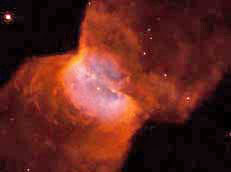
The “planetary nebula”
NGC 2346, revealing the telltale hour-glass form.
|
The nebula of Eta Carinae certainly
belongs in that category. If the nebula
is a plasma heated by electric
currents feeding into star of Eta Carinae then, just as
with our own sun, the highest "temperatures" are encountered
beyond the star. That is why there is relatively little radiation
from the star at the center. Most of the electrical power focused on
the hapless star is being intercepted by gas and dust in the nebula
and radiated energetically into space.
Thus, Dr. Fred Seward of the
Harvard-Smithsonian Center for Astrophysics expressed great surprise
at what he saw:
"I expected to see a strong point source with a
little diffuse emission cloud around it. Instead we see just the
opposite— a bright cloud of diffuse emission, and much less
radiation from the center.”
|
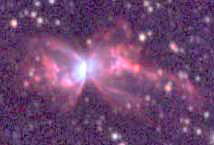
The Bug Nebula, spanning
about one third of a light year, but retaining the
hourglass form of the plasma pinch. The light of the
star is rich in ultraviolet, one of the signatures of
electric discharge. |
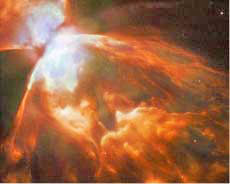
A higher resolution
Hubble Telescope image of the Bug Nebula.
|
Though a lot is happening close to the highly energetic pinch point,
the hourglass form can be discerned in relation to the pinch, and
stands in a predictable relationship to the “pitchfork”
configuration of cylindrical current sheets.
These are by no means the only “hourglass” formations exhibited by
nebula. In the Bug Nebula above, for example, many indications of
electrical activity are evident. The central star is hidden by a
dark dust torus.
And the shapes within the nebula mimic the twisted
filaments, spirals and pillars typical of electrical discharge in
plasmas.
Conclusion
In this investigation, converging paths of inquiry demand a
reconsideration of popular beliefs in the sciences and social
sciences. We can no longer view the history of human
consciousness—or the history of our planet—through the lens of
twentieth century cosmology.
The myths and symbols of antiquity will have a central place in this
reconsideration. Though presented in the language of myth and
symbol, ancient accounts of the warrior, the dragon, and cosmic
combat are filled with images of electricity. The "thunderbolts of
the gods" defy every effort to understand them as references to
familiar lightning. They spiral and whirl and entwine. They blossom
as a flower, or stand as a great pillar supporting the sky. Their
forms are not the forms of regional lightning, but of plasma discharge in plasma laboratory experiments.
The ancient “lightning gods,” such as the Greek Zeus or
Apollo, move
about as fierce and towering forms in the heavens. In their
appearance, these gods answer to no recognizable entity or force of
nature, and the chroniclers’ descriptions will tempt us to regard
the myth-makers themselves as relentless liars. But a much different
understanding of ancient accounts is possible, if we grant to the
original witnesses a certain integrity. We do not need to regard
their testimony as "scientifically accurate." We need only
acknowledge that the core themes of mythology may have originated in
extraordinary natural events, for which ancient races had no
cultural preparation.
If this was the case, the stories are a form of historic testimony
in the only languages that were available to the eyewitnesses
themselves. It then becomes clear that around the world many
different hieroglyphs and symbols actually described identical
celestial phenomena. This discovery, in turn, requires that we
follow the logical rules for dealing with converging testimony. How
do we uncover the forgotten events now hidden behind the symbols
they inspired?
As discoveries in plasma science continue, we can be assured that
our comparative analysis of ancient sources need not take place in
isolation from other fields of evidence. The testimony of ancient
witnesses will find many corollaries in laboratory research and in
new vistas in space.
Return
|



















































